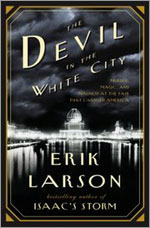| |
2000s |
| |
After Dark, Haruki Murakami
The Amazing Adventures of Kavalier & Clay, Michael Chabon
Asterios Polyp, David Mazzucchelli
Atonement, Ian McEwan
August: Osage County, Tracy Letts
The Book of Revelation, Rupert Thomson
The Corrections, Jonathan Franzen
Chronicles Volume One, Bob Dylan
The Devil in the White City: Murder, Magic and Madness at the Fair That Changed America, Erik Larson
Empire Falls, Richard Russo
A Fraction of the Whole, Steve Toltz
The Gum Thief, Douglas Coupland
A Heartbreaking Work of Staggering Genius, Dave Eggers
The Inheritance of Loss, Kiran Desai
The Inner Circle, T.C. Boyle
The Living, Pascale Kramer
Love in Infant Monkeys, Lydia Millet
The Monsters of Templeton, Lauren Groff
On Chesil Beach, Ian McEwan
Prodigal Summer, Barbara Kingsolver
The Secret Scripture, Sebastian Barry
The Story of Edgar Sawtelle, David Wroblewski
The Tender Bar, J.R. Moehringer
The Year of Magical Thinking, Joan Didion
Then We Came to the End, Joshua Ferris
Veronica, Mary Gaitskill
Zeitoun, Dave Eggers |
|
|
The Devil in the White City: Murder, Magic and Madness at the Fair That Changed America, Erik Larson
Crown, February 11, 2003
Being blindsided by the secrets of your past is not what clenched my heart and yanked like Olympian hands pulling a taught rope in a losing game of tug of war. Understanding that I, alone, am at fault for indiscriminant ignorance was what nearly disemboweled the warm muscle pumping life force through my veins.
No blame could fall upon your broad shoulders for an absence of truth. You did not conceal facts. My mistake was not caring enough to inquire deeper—to venture down alleys of your former vitality and around corners adjacent to self-imposed comfort zones. Much was taken for granted, as I lazily succumbed to an idealized vision of your winsome charm. Every single day, until pages exposed a tacit history, romanticized notions of your allure inhabited my thoughts, which were imbued with unearned and undying admiration.
You, the City of Chicago. The birthplace of me. Bearing so much more than the days of my existence and careless complaisance.
Walking along the Magnificent Mile, the majesty of the John Hancock Center to the north, the Wrigley Building at my side, and the Michigan Avenue Bridge suspending me amid your effervescence, I never felt anything less than connected to home. Regardless, the river currents flowing backward below could not wash sanguine perceptions toward the midst of a whole you.
I only saw landmarks. Present-day buildings, signs and waterways, which exuded a calming sense of place, prevented me from admiring bulldozed monuments and achievements equal to the marvels left standing; accomplishments from the past were even obstructed from imagination. A life adulating the obvious was to blame and a mistake vowed unrepeated. Renewed vision razed the land.
The World’s Columbia Exposition of 1893, The World’s Fair, flourished on your soil. I am certain now, but because tangible remnants of its grandeur existed outside the furthest reaches of my peripheral view, the promise of the feat, as well as the horrors it enticed, lay dormant under the shiny surface of avenues I professed: Evidence of the expo’s construction—the splendor of The Court of Honor with a statue of “Big Mary” presiding over expansive pools and the dramatic architecture of the Manufactures and Liberal Arts Building, not to mention the panorama from the heights of George Washington Gale Ferris’s first “great wheel” boosting moribund passengers two hundred sixty-four feet in the air—vanished almost so completely and so long ago that a measured leap of faith may always be required to believe; however, The White City, named so because edificial walls on the fairgrounds were uniformly bleached of polluting color in a resounding impression of perfection and goodness, was undeniably real. Gleaning the story of that magnificent pavilion and those flocking to it left me wanting to touch the blank walls, which held daily exhibitions of kaleidoscopic masterpieces, as their stretched canvas was brushed with God’s iridescent twilight or reflected the silvery beams of the moon. I was drawn through entrance gates opened once again.
Histories are lost without traces like lives snuffed at the darkened, blood-soaked hands of a killer crafting destruction in cases gone cold: Man holds an innate ability to create and condemn anything in his path. Shockingly, I nearly eradicated a vital part of you by failing to snoop as a relentless detective, deducing truths crumbled by the vestiges of time. A passive observer no more, I regard inconspicuous monuments along the lakefront and in the back-story of evils and heroes visiting before my understanding.
A stroll through the streets of Paris invites glimpses of the Eiffel Tower, proudly standing as a testament of majesty and innovation with its own circumstance; the steel structure’s iconic silhouette is as impactful as ever in person or in reproduced image over a century after the fair departed that city. In New York, whose Unisphere and Parachute Jump serve as reminders of two separate exhibitions, as well as in Seattle, where The Space Needle threads the skyline, cornerstones of architectural achievement preserve the integrity and spirits of the past. Nevertheless, in Chicago, iconic reminders of the relevance of days bestowed the gracious host, such as Ferris’s first wheel, are dismantled, relocated and collapsed into a jumbled scrap heap or camouflaged by modernization. Unfair—perhaps—but hard-won appreciation cannot be knocked down.
Please accept forgiveness for youthful inattention, my dear city. The fairground is appropriately set in the foreground through eternity.
-MEG

|
|
 |

